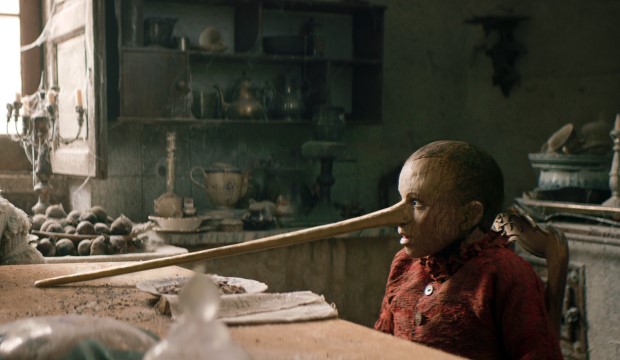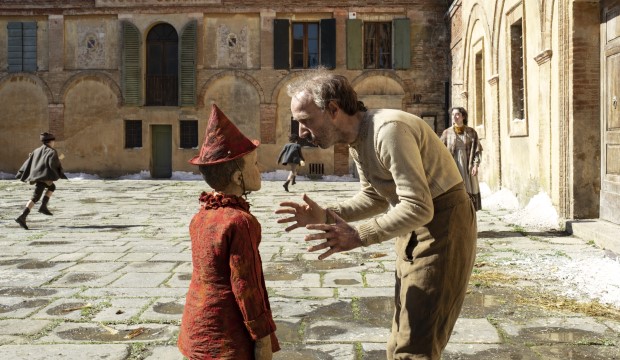Pinocchio (2020) film review ★★★★★
Matteo Garrone's darker, more faithful adaptation of Pinocchio wields a dark visual power but becomes strangely mundane. Roberto Benigni (Down By Law, Life is Beautiful) stars
Federico Ielapi in Pinocchio (2020)
Nope,
not the Disney remake that’s (supposedly) coming out next year. In this
precarious era of constant, constant live-action Disney remakes, the lethargy only
exacerbates when other studios have a go. For example: Jon Favreau’s The Jungle Book (Disney) coming before Andy Serkis’s Mowgli: Legend of the Jungle (Netflix) secured a lukewarm reception for the latter.
Lucky news, then, for the latest Italian adaptation of Pinocchio, which comes a year before Guillermo del Toro's official Disney remake and follows the darker, pre-Disneyfied original novel by Carlo Collodi. The advantageous timing allows director Matteo Garrone some wiggle room for success in his version which, despite lacking a vital childish energy, wields a creepy visual power.

Pinocchio (Francesco Ielapi) lies and, well...
This Pinocchio bursts with beautifully illustrative, live-action visuals; Nicolaj Bruel's cinematography pushing into tangible realisations that'd fit nicely inside a Grimm fairytale. The adventurous script by Garrone and Massimo Ceccherini plods along episodically as Collodi’s little, wooden, wannabe child – made from a magical log by a penniless Geppetto (a mostly wasted Roberto Benigni) – runs with abandon between strange Italian lands.
Garrone and Ceccherini recreate potentially traumatising pictures: including hangings, near-drownings and illnesses verging on death. Classical human-animal hybrids, crafted with Lewis Caroll-inspired creativity, also pop up in the forms of bird people, snail people, rabbit people and monkey people. All embrace this magical nightmare.
Mark Coulier and Rachael Penfold’s design for Pinocchio can't be praised enough: carefully carved, if a little frightening. You can see every ridge of Geppetto’s craftsmanship, the CG realism competing with the Hollywood standard.
But these visual merits, certain to affect even the most strident of realists, become weirdly mundane in the absence of a likeable hero. This is nothing to do with Federico Ielapi’s shrill yet engaging performance as Pinocchio, but with Pinocchio as a character. He's irritating enough to want to throw in the fire. Any fire, as soon as possible, just to make those obnoxious squeals stop.

Geppetto (Roberto Benigni) carves Pinocchio from a magical log
Much of the story's moral heart immortalised by Disney is dissolved; there’s no Jiminy Cricket conscience here – or not much of one. Why should we care about this raucous, idiotic puppet when he’s so annoying?
Pinocchio’s moral direction is eventually guided by The Fairy, cheekily played by Alida Baldari Calabria in youth and by a luminous Marine Vacth in adulthood. Scenes between her and Pinocchio are among the most enjoyable, showing a genuine friendship instead of something more maternal. When they play inside an abandoned house, Garrone and Ceccherini gel together with childlike fun and kooky fairytale surrealism – a union that's strangely scarce in the film.
The script and the direction have an exhausted feel of just getting through the story, stepping from bleak beat to bleak beat without much mirth in between. Even the most horrific scenes lose their entertainment potential, presumably to retain their family audience. Garrone’s Pinocchio has an interesting face, but a wooden heart.
Pinocchio is released in UK cinemas on Friday 14 August
Lucky news, then, for the latest Italian adaptation of Pinocchio, which comes a year before Guillermo del Toro's official Disney remake and follows the darker, pre-Disneyfied original novel by Carlo Collodi. The advantageous timing allows director Matteo Garrone some wiggle room for success in his version which, despite lacking a vital childish energy, wields a creepy visual power.

Pinocchio (Francesco Ielapi) lies and, well...
This Pinocchio bursts with beautifully illustrative, live-action visuals; Nicolaj Bruel's cinematography pushing into tangible realisations that'd fit nicely inside a Grimm fairytale. The adventurous script by Garrone and Massimo Ceccherini plods along episodically as Collodi’s little, wooden, wannabe child – made from a magical log by a penniless Geppetto (a mostly wasted Roberto Benigni) – runs with abandon between strange Italian lands.
Garrone and Ceccherini recreate potentially traumatising pictures: including hangings, near-drownings and illnesses verging on death. Classical human-animal hybrids, crafted with Lewis Caroll-inspired creativity, also pop up in the forms of bird people, snail people, rabbit people and monkey people. All embrace this magical nightmare.
Mark Coulier and Rachael Penfold’s design for Pinocchio can't be praised enough: carefully carved, if a little frightening. You can see every ridge of Geppetto’s craftsmanship, the CG realism competing with the Hollywood standard.
But these visual merits, certain to affect even the most strident of realists, become weirdly mundane in the absence of a likeable hero. This is nothing to do with Federico Ielapi’s shrill yet engaging performance as Pinocchio, but with Pinocchio as a character. He's irritating enough to want to throw in the fire. Any fire, as soon as possible, just to make those obnoxious squeals stop.

Geppetto (Roberto Benigni) carves Pinocchio from a magical log
Much of the story's moral heart immortalised by Disney is dissolved; there’s no Jiminy Cricket conscience here – or not much of one. Why should we care about this raucous, idiotic puppet when he’s so annoying?
Pinocchio’s moral direction is eventually guided by The Fairy, cheekily played by Alida Baldari Calabria in youth and by a luminous Marine Vacth in adulthood. Scenes between her and Pinocchio are among the most enjoyable, showing a genuine friendship instead of something more maternal. When they play inside an abandoned house, Garrone and Ceccherini gel together with childlike fun and kooky fairytale surrealism – a union that's strangely scarce in the film.
The script and the direction have an exhausted feel of just getting through the story, stepping from bleak beat to bleak beat without much mirth in between. Even the most horrific scenes lose their entertainment potential, presumably to retain their family audience. Garrone’s Pinocchio has an interesting face, but a wooden heart.
Pinocchio is released in UK cinemas on Friday 14 August
TRY CULTURE WHISPER
Receive free tickets & insider tips to unlock the best of London — direct to your inbox
| What | Pinocchio (2020) film review |
| When |
14 Aug 20 – 14 Aug 21, TIMES VARY |
| Price | £determined by cinemas |
| Website | Click here for more information |